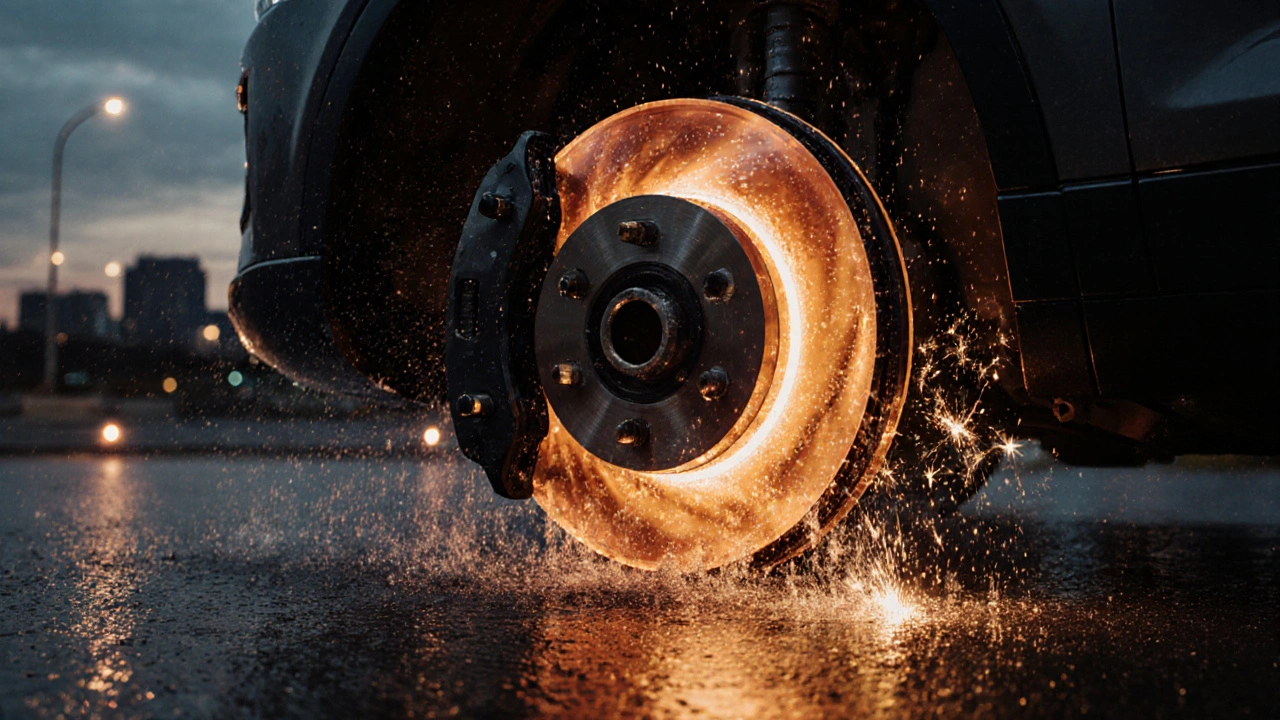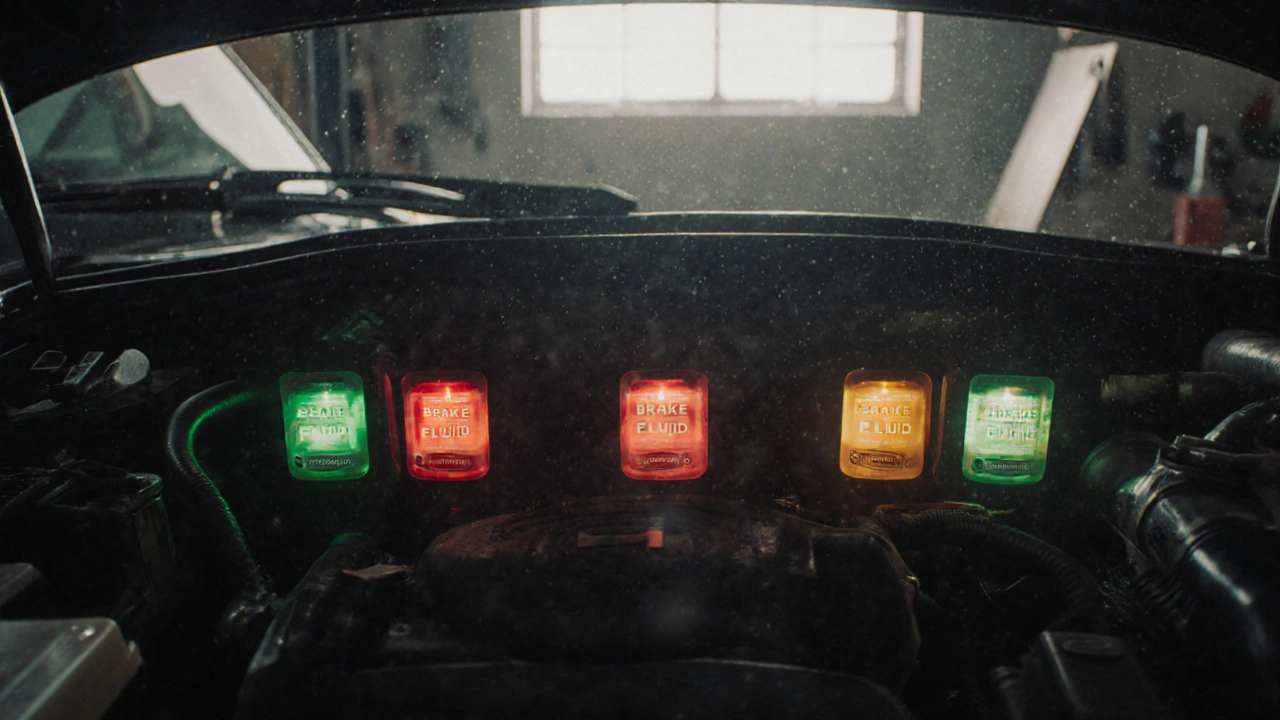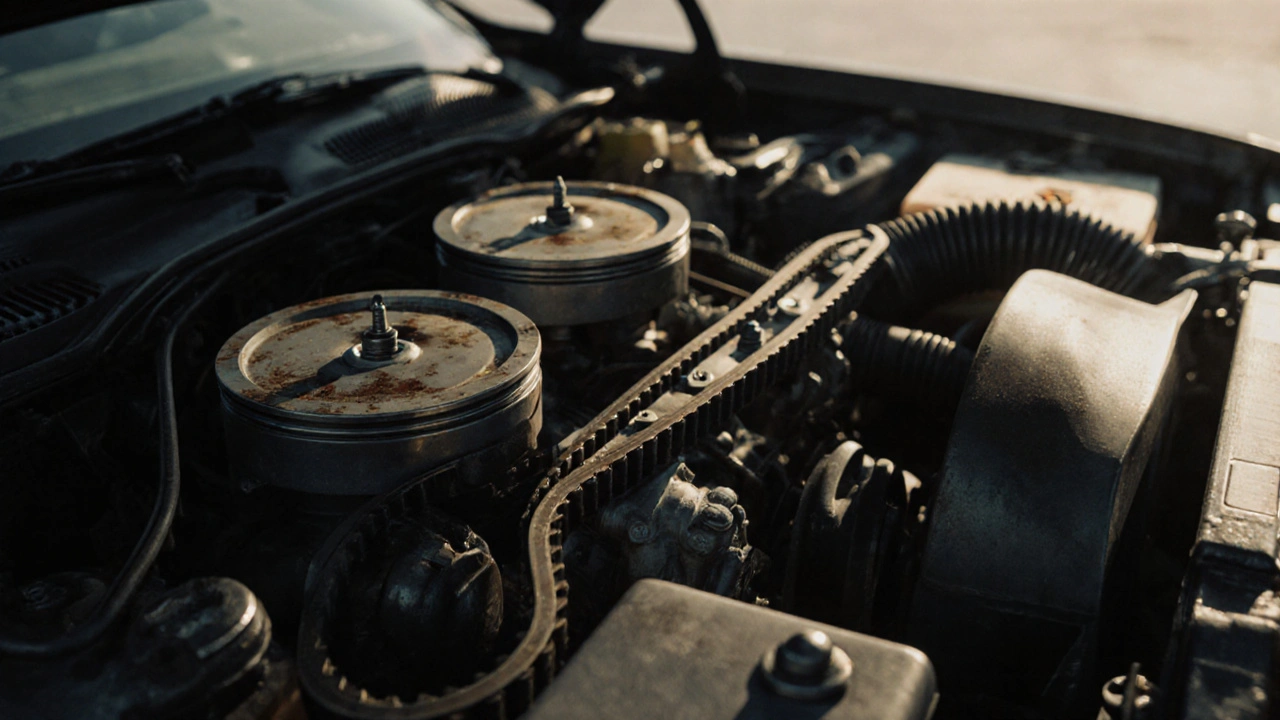Your car isn’t just a machine-it’s a team of hundreds of parts working together, every second you drive. One worn brake pad, one cracked hose, one loose bolt-any one of them can turn a smooth ride into a roadside nightmare. Knowing what these parts do, and when they need attention, isn’t about being a mechanic. It’s about staying safe and saving money.
Engine Parts: The Heart of Your Car
The engine is where the magic happens. It turns fuel into motion, and it’s made up of dozens of critical parts. The pistons move up and down inside the cylinders, compressed by the spark plugs. The timing belt or chain keeps everything synchronized. If the timing belt snaps, you could bend valves, crack pistons, or destroy the whole engine. Most manufacturers say to replace it every 60,000 to 100,000 miles. Don’t wait for the check engine light-it’s already too late.
Oil doesn’t just lubricate. It cools, cleans, and protects. Old oil turns to sludge. That’s why you need an oil change every 5,000 to 7,500 miles, depending on your car and driving habits. Synthetic oil lasts longer and handles extreme heat better. If you drive in stop-and-go traffic or haul heavy loads, stick with synthetic.
Brake System: Your Most Important Safety Feature
Brakes aren’t just pads and rotors. They’re a hydraulic system: master cylinder, brake lines, calipers, fluid, and sensors. When you press the pedal, fluid pressure squeezes the pads against the rotors. That friction slows you down. But brake fluid absorbs moisture over time. Water in the fluid lowers its boiling point. On a long downhill stretch, that can mean spongy brakes-or worse, total failure.
Brake pads wear out. Most last between 25,000 and 70,000 miles, depending on how you drive. If you hear a high-pitched squeal, that’s the wear indicator. Don’t ignore it. Rotors can get warped from overheating. If your steering wheel shakes when you brake, the rotors might be uneven. Replacing pads and rotors together gives you smoother stops and longer life.
Suspension Components: Control, Comfort, and Safety
Shock absorbers and struts don’t just make your ride smooth. They keep your tires on the road. Worn shocks mean longer stopping distances, poor handling in turns, and uneven tire wear. You can test them with the bounce test: push down hard on one corner of the car. If it bounces more than once or twice, they’re done.
Control arms, ball joints, and bushings connect the wheels to the frame. When they wear out, your car can pull to one side, or you might hear clunking over bumps. These parts don’t always show up on a diagnostic scan. You need a visual inspection. Most last 80,000 to 100,000 miles, but potholes and rough roads cut that in half.
Transmission: The Power Bridge
Automatic or manual, the transmission transfers engine power to the wheels. It’s full of gears, clutches, and fluid. Transmission fluid breaks down over time. It gets dirty, loses its grip, and stops cooling properly. Most people don’t change it until it slips. That’s too late. Manufacturers say every 60,000 to 100,000 miles-but if you tow, drive in heavy traffic, or live in a hot climate, do it every 40,000.
Manual transmissions have clutches. If the pedal feels spongy or you smell burning, the clutch is wearing out. Replacing a clutch isn’t cheap, but it’s cheaper than a rebuilt transmission.

Electrical System: More Than Just the Battery
Most people think the battery is the only thing that matters. But the alternator charges it. The starter turns the engine over. Sensors monitor everything from oxygen levels to coolant temperature. A failing alternator won’t kill your car right away. It’ll drain the battery slowly. You might notice dim headlights, slow power windows, or warning lights that come on at night.
Batteries last 3 to 5 years. Cold weather kills them faster. If your car struggles to start in the morning, especially in winter, it’s not the cold-it’s the battery. Get it tested at any auto parts store. They’ll do it for free. Replace it before it leaves you stranded.
Tires and Wheels: The Only Contact With the Road
Tires are the only part of your car touching the pavement. That makes them the most important safety component. Tread depth matters. The legal minimum is 2/32 of an inch, but studies show stopping distances jump dramatically below 4/32. Use the penny test: put a penny head-down in the tread. If you can see Lincoln’s head, it’s time for new tires.
Pressure matters too. Underinflated tires wear out faster, hurt fuel economy, and overheat. Overinflated ones wear the center and make the ride harsh. Check pressure every month, and always when the tires are cold. Your door jamb or owner’s manual has the right number-not the number on the tire sidewall.
Fluids: The Lifeblood of Your Car
Every fluid has a job. Coolant keeps the engine from overheating. Power steering fluid makes turning easy. Brake fluid transfers pressure. Transmission fluid lubricates gears. Windshield washer fluid keeps your view clear.
Don’t just top them off. Check the color and clarity. Coolant should be bright green, red, or orange. If it’s brown or has rust flakes, flush the system. Power steering fluid should be clear, not milky. Milky fluid means water got in-that’s a leak, and it’s serious.
Fluids degrade. They don’t last forever. Follow the schedule in your owner’s manual. If you don’t have it, ask a mechanic. Most shops have digital databases with factory specs.

What to Watch For: Early Warning Signs
You don’t need to be a mechanic to spot trouble. Here’s what to listen for and feel:
- Grinding or squealing when braking-pad wear or rotor damage
- Clicking noise when turning-bad CV joint
- Vibration in the steering wheel-unbalanced tire or worn suspension
- Smoke from the exhaust-blue smoke means oil burning, white smoke means coolant leak, black smoke means too much fuel
- Dashboard lights that stay on after startup-don’t ignore them
Most of these issues start small. Fix them early, and you avoid $2,000 repairs. Wait, and you might need a whole new transmission or engine.
When to Replace vs. Repair
Not every broken part needs a full replacement. Sometimes, a sensor can be cleaned. A leaky gasket can be fixed. But some parts are better replaced outright.
Replace: timing belts, brake pads, shocks, batteries, tires, spark plugs, fuel filters.
Repair: minor leaks, worn bushings, alternator brushes, minor electrical faults.
Ask your mechanic: "Is this something that’s likely to fail again soon?" If the answer is yes, replace it. A cheap fix now might cost more later.
How to Stay Ahead of Problems
Keep a simple log. Write down:
- Date of oil change
- Tire pressure checked
- Brake inspection done
- Fluid levels checked
- Any unusual sounds or behaviors
Use a free app like Carfax or MyCarFax to track maintenance. Set phone reminders for oil changes every 6 months, even if you haven’t hit the mileage. Time matters as much as miles.
Don’t skip the annual safety inspection. It’s not just paperwork. A trained eye will spot things you miss-cracked hoses, rusted brake lines, worn steering components.
Final Thought: Car Parts Are Your Responsibility
Your car doesn’t care if you’re busy, tired, or broke. It just keeps running-until it doesn’t. The cost of ignoring small problems isn’t just money. It’s safety. It’s stress. It’s being stranded on the side of the road in the rain.
Knowing your car parts isn’t about becoming an expert. It’s about being smart. Check fluids. Listen for sounds. Watch the dashboard. Replace worn parts before they fail. That’s how you keep your car running for 200,000 miles-or even 300,000.
How often should I replace my car’s brake pads?
Brake pads typically last between 25,000 and 70,000 miles, but it depends on your driving style. Aggressive braking, frequent city driving, or hauling heavy loads wears them out faster. Listen for a high-pitched squeal-that’s the wear indicator. If you feel vibration when braking, the rotors may be warped and should be replaced with the pads.
Can I drive with a bad suspension?
Driving with worn shocks or struts is dangerous. It reduces your ability to stop quickly, makes the car harder to control in turns, and causes uneven tire wear. You might not notice right away, but your stopping distance increases by up to 20% with bad suspension. Replace them as soon as you notice clunking noises or excessive bouncing.
Why is my car’s battery dying so fast?
Batteries usually last 3 to 5 years. If yours dies sooner, it could be due to short trips that don’t fully recharge it, extreme cold, or a faulty alternator. Leaving lights or electronics on while the engine is off also drains it. Have the battery and charging system tested at any auto parts store-they do it for free.
What happens if I ignore a check engine light?
Some check engine lights are minor, like a loose gas cap. Others mean serious problems-misfires, catalytic converter failure, or sensor malfunctions. Ignoring it can lead to engine damage, poor fuel economy, or even a breakdown. Even if the car seems fine, get it scanned. Most auto shops offer free diagnostic checks.
How do I know if my tires need replacing?
Use the penny test: insert a penny into the tread with Lincoln’s head upside down. If you can see the top of his head, your tread is below 2/32 inch-the legal minimum. But for safety, replace tires when tread hits 4/32 inch. Also look for cracks on the sidewalls, bulges, or uneven wear, which point to alignment or suspension issues.
Should I use synthetic oil in my car?
If your car’s manual recommends it, use synthetic. Even if it doesn’t, synthetic oil lasts longer, flows better in cold weather, and protects better under heavy loads or high heat. It’s more expensive upfront, but you can go longer between changes-often up to 10,000 miles. For most modern cars, synthetic is the smarter choice.
If you’re unsure about any part or symptom, trust a trusted mechanic-not a random online opinion. Your car’s health depends on what you do before the problem gets big.

Kendall Storey
November 5, 2025 AT 05:46Yo, if you’re still using conventional oil in a modern car, you’re basically feeding your engine mud. Synthetic? Non-negotiable. I’ve got 180k on my Civic and never had a valve issue-just changed the oil every 10k with full synthetic and never looked back. Also, don’t sleep on transmission fluid. People think it’s a ‘lifetime’ fluid-bullshit. If you tow or drive in city traffic, swap it at 40k. Your transmission will thank you.
Ashton Strong
November 6, 2025 AT 10:18It is of paramount importance to recognize that the integrity of one’s automotive system is directly proportional to the diligence with which routine maintenance is executed. The hydraulic integrity of the brake system, for instance, is compromised by moisture ingress over time, thereby necessitating periodic fluid exchanges in accordance with manufacturer specifications. Furthermore, the substitution of worn brake pads prior to rotor degradation is not merely advisable-it is an imperative for vehicular safety.
Steven Hanton
November 8, 2025 AT 02:24I’ve been reading through this and it’s really well put together. I used to ignore my car until something broke-then I’d panic. Now I check fluids every time I fill up. Simple habit, huge difference. I also started writing down oil changes in a notebook. Feels old-school, but it works. I’m not a mechanic, but I’ve learned enough to ask the right questions at the shop. That’s half the battle.
Pamela Tanner
November 9, 2025 AT 02:19Thank you for this comprehensive breakdown. It’s refreshing to see a post that doesn’t just list parts but explains their function and consequences of neglect. I’ve shared this with my sister-she just bought her first car and has no idea how to maintain it. This is exactly the kind of clear, factual guidance people need before they get taken advantage of at the shop.
Kristina Kalolo
November 11, 2025 AT 00:37One thing I learned the hard way: don’t trust tire pressure numbers on the sidewall. My husband did that once and we got terrible fuel economy. Found out the real number was on the driver’s door jamb. Now I check every month with a good gauge. Small thing, big difference.
ravi kumar
November 11, 2025 AT 06:36My Tata Safari lasted 220k km because I changed fluids on time and never waited for warning lights. In India, people think cars are disposable. But if you treat them right, they’ll carry you for decades. Suspension parts? Replace them before they break. One bad shock and your whole axle can go. Been there.
Megan Blakeman
November 11, 2025 AT 07:26I used to think cars were just… cars. Then my brake light came on and I panicked. Turned out it was just a sensor, but I cried. Like, actual tears. Now I check my oil like it’s my emotional support ritual. I even made a sticky note on my fridge: "Check tires. Check fluids. Don’t be dumb." And I’m not even a mechanic. I just don’t want to die in a ditch because I was lazy.
Akhil Bellam
November 12, 2025 AT 10:37Wow. Just… wow. This post reads like a 4th-grade manual for people who think "oil change" is a spa treatment. You didn’t mention that most people who drive without synthetic oil are essentially running their engines on motor oil that’s been sitting in a garage since 2017. And let’s not even get into the fact that 90% of brake jobs are done wrong because the mechanic didn’t resurface the rotors. If you’re not replacing pads AND rotors together, you’re not fixing it-you’re just delaying the inevitable. And if you’re still using a penny test for tread depth? Honey, you’re not saving money-you’re gambling with your life. Get a gauge. Or better yet-get a new car.